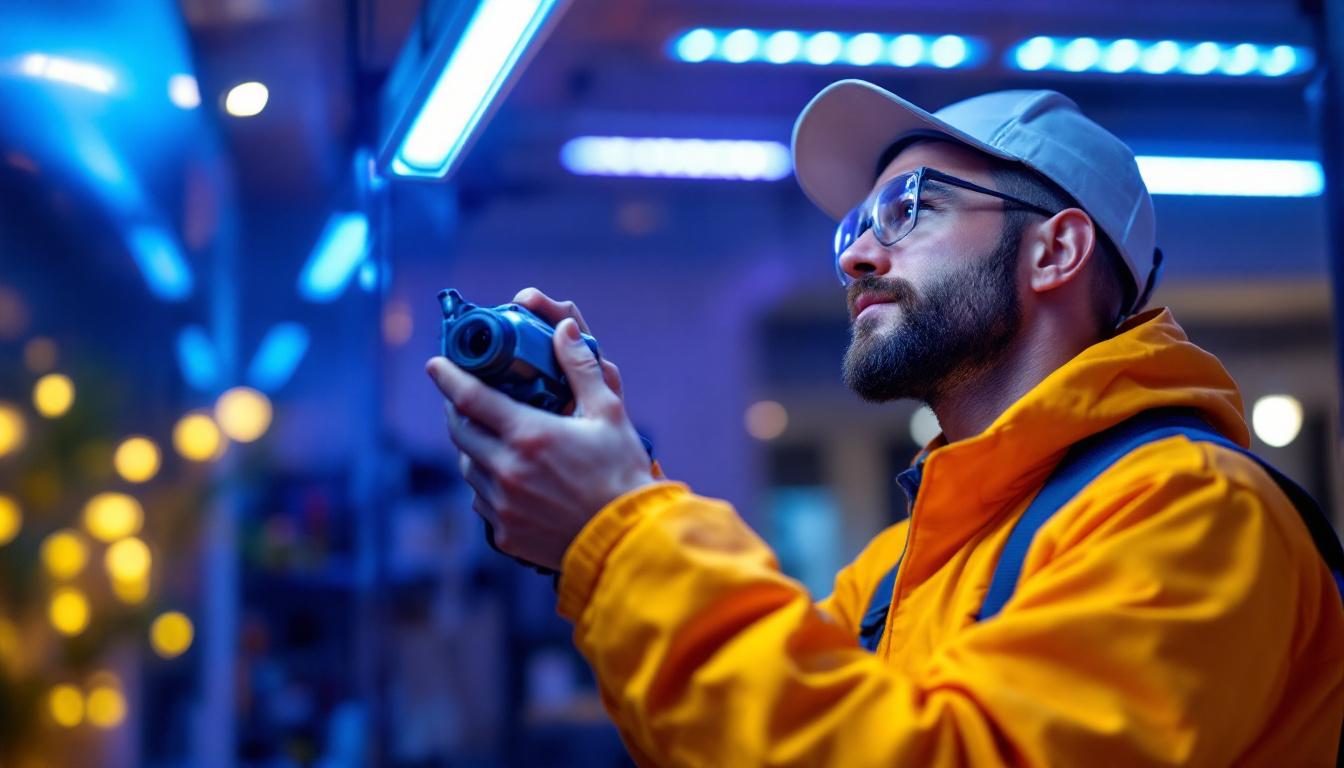
As the world continues to evolve technologically, the advent of LED lighting has revolutionized the way we illuminate our spaces. For lighting contractors, understanding the history and development of LED lights is crucial not only for technical knowledge but also for providing clients with informed choices. This article delves into the origins of LED technology and offers insights into how lighting contractors can harness this knowledge to enhance their services.
Before diving into the specifics of LED lights, it’s essential to understand the broader context of lighting technology. From the early days of candles and gas lamps to the introduction of incandescent bulbs, each advancement has paved the way for modern lighting solutions. The transition from traditional lighting methods to more energy-efficient options has been a significant trend in the industry. The quest for better lighting has not only been about illumination but also about enhancing the quality of life, influencing mood, and even impacting productivity in workspaces.
Incandescent bulbs, which have been a staple in households for decades, provided a warm glow but were notorious for their inefficiency. The shift towards fluorescent lighting marked a pivotal moment in the quest for energy efficiency. Fluorescent lights consume less power and have a longer lifespan, making them an attractive option for both residential and commercial applications. Their ability to produce a brighter light while using a fraction of the energy of incandescent bulbs led to widespread adoption in offices, schools, and public spaces.
However, the limitations of fluorescent lighting, such as flickering and the presence of harmful substances like mercury, necessitated further innovation. This paved the way for the development of LED technology, which promised even greater efficiency and versatility. The growing awareness of environmental issues and the need for sustainable practices further fueled the demand for lighting solutions that minimized ecological impact, steering the industry towards a future where energy-efficient lighting was not just preferred but essential.
The concept of light-emitting diodes (LEDs) originated from the discovery of electroluminescence. This phenomenon, where materials emit light when an electric current passes through them, laid the groundwork for the development of LED technology. Early LEDs were primarily used in indicators and displays, but their potential for general lighting applications was soon recognized. The compact size and durability of LEDs made them ideal for a variety of settings, from automotive lighting to decorative applications.
As research progressed, advancements in semiconductor technology allowed for the creation of brighter and more efficient LEDs. This marked the beginning of a new era in lighting, where energy efficiency and longevity became paramount. The introduction of white LEDs, which combined different colors of light to produce a bright, natural illumination, opened up new possibilities for residential and commercial lighting design. Not only did LEDs reduce energy consumption significantly, but they also offered flexibility in color temperature and brightness, allowing users to create customized lighting environments that enhance aesthetics and functionality in any space.
To effectively utilize LED technology, lighting contractors must grasp the fundamental principles behind how LEDs work. This understanding not only aids in installation but also empowers contractors to educate clients about the benefits of LED lighting.
LEDs operate on a simple principle: when an electric current passes through a semiconductor material, it emits light. The color of the light emitted depends on the materials used in the semiconductor. This characteristic allows for a wide range of colors and applications, from warm white to vibrant hues.
One of the most significant advantages of LEDs is their energy efficiency. Unlike incandescent bulbs that convert a significant portion of energy into heat, LEDs convert most of their energy into light. This efficiency translates into lower energy bills and reduced environmental impact, making them a preferred choice for eco-conscious consumers.
LED lighting offers numerous benefits that make it an attractive option for both residential and commercial applications. Some of the key advantages include:
For lighting contractors, mastering LED technology goes beyond understanding its history and functionality. It involves staying updated on the latest trends, best practices, and installation techniques. Here are some strategies to help contractors excel in the LED lighting market.
The lighting industry is continually evolving, with new products and technologies emerging regularly. Contractors should make it a priority to stay informed about the latest trends in LED lighting. This includes attending trade shows, participating in webinars, and subscribing to industry publications.
By staying informed, contractors can offer clients the most up-to-date solutions, ensuring they remain competitive in the market. Additionally, understanding trends can help contractors anticipate client needs and preferences, allowing for tailored recommendations.
Conducting energy audits is an essential service that lighting contractors can offer. By assessing a client’s current lighting setup, contractors can identify areas where LED lighting can provide significant energy savings. This not only helps clients reduce their energy bills but also positions contractors as knowledgeable professionals who prioritize sustainability.
Energy audits can also serve as a valuable marketing tool. By showcasing the potential savings and benefits of switching to LED lighting, contractors can attract new clients and retain existing ones. Providing detailed reports and recommendations can enhance client trust and satisfaction.
Every client has unique lighting needs, and offering customized solutions can set a contractor apart from the competition. Understanding the specific requirements of each project—whether it’s for residential, commercial, or industrial applications—enables contractors to recommend the most suitable LED products.
Additionally, contractors should consider factors such as color temperature, brightness levels, and fixture types when designing lighting solutions. By providing tailored recommendations, contractors can enhance the overall aesthetic and functionality of the spaces they illuminate.
Proper installation is critical to maximizing the benefits of LED lighting. Lighting contractors should adhere to best practices to ensure optimal performance and longevity of LED fixtures. Here are some key considerations during installation.
Not all LED fixtures are compatible with existing electrical systems. Contractors must ensure that the fixtures they choose are suitable for the specific application and can work seamlessly with existing wiring and controls. This may involve selecting compatible dimmers or drivers to prevent flickering or reduced performance.
In some cases, retrofitting existing fixtures with LED components may be a viable option. Contractors should assess the feasibility of retrofitting versus complete replacement, considering factors such as cost, efficiency, and client preferences.
Effective lighting design is crucial for achieving the desired ambiance and functionality in a space. Contractors should consider factors such as the layout of the room, the purpose of the space, and the natural light available. Proper placement of LED fixtures can enhance the overall lighting experience.
Moreover, understanding the principles of layering light—using ambient, task, and accent lighting—can help contractors create well-balanced lighting schemes. This approach not only improves aesthetics but also enhances the usability of the space.
After installation, thorough testing is essential to ensure that the LED lighting system operates as intended. Contractors should check for issues such as flickering, color consistency, and brightness levels. Addressing any problems during the installation phase can prevent future complications and enhance client satisfaction.
Implementing a quality assurance process can also help contractors build a reputation for reliability and professionalism. This commitment to quality can lead to repeat business and referrals, which are invaluable in the competitive lighting industry.
As technology continues to advance, the future of LED lighting holds exciting possibilities. Innovations such as smart lighting systems, tunable white light, and integration with IoT (Internet of Things) are transforming the way we approach lighting design and installation.
Smart lighting systems allow users to control their lighting through mobile apps or voice commands, providing convenience and flexibility. For contractors, understanding how to integrate smart technology with LED fixtures can open new avenues for business. This includes offering clients the option to customize their lighting settings based on their preferences and routines.
Furthermore, smart lighting can enhance energy efficiency by allowing users to schedule lighting usage and adjust brightness levels based on occupancy. Contractors who can provide these advanced solutions will be well-positioned in the evolving market.
As sustainability becomes a priority for consumers and businesses alike, the demand for energy-efficient lighting solutions will continue to grow. Contractors who prioritize environmentally friendly practices—such as using sustainable materials and promoting energy-efficient products—will appeal to a broader audience.
Additionally, understanding the environmental impact of different lighting options can help contractors make informed recommendations to clients. This commitment to sustainability can enhance a contractor’s reputation and contribute to a more sustainable future.
The invention of LED lighting has marked a significant turning point in the lighting industry, providing unparalleled energy efficiency and versatility. For lighting contractors, mastering the intricacies of LED technology is essential for staying competitive and meeting the evolving needs of clients.
By understanding the history of LED lights, staying informed about industry trends, and implementing best practices in installation and design, contractors can position themselves as experts in the field. As the future of lighting continues to unfold, embracing innovation and sustainability will be key to thriving in this dynamic industry.
Ready to elevate your lighting game? LumenWholesale is your trusted partner, offering an exceptional range of LED lighting solutions that blend quality, efficiency, and cost-effectiveness. Our commitment to providing spec-grade lighting products at wholesale prices ensures that you can tackle any project with confidence. Say goodbye to local distributor markups and hello to a world of hassle-free bulk purchases, complete with free shipping. Don’t compromise on quality or value—choose LumenWholesale for your next lighting endeavor. Visit our website and discover the best in Wholesale Lighting at the Best Value today.

Discover the top strategies lighting contractors use to optimize outdoor spaces with LED flood lights.

Discover the essential facts about ceiling fan dimmers that every lighting contractor needs to know.

Discover how MR16 LED bulbs are revolutionizing the lighting industry for contractors.

Discover the essential guide for lighting contractors on wiring a three-way toggle switch.